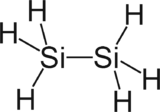Parent structure


In IUPAC nomenclature, a parent structure, parent compound, parent name or simply parent is the denotation for a compound consisting of an unbranched chain of skeletal atoms (not necessarily carbon), or consisting of an unsubstituted monocyclic or polycyclic ring system. [1] Parent structures bearing one or more functional groups that are not specifically denoted by a suffix are called functional parents. [2] Names of parent structures are used in IUPAC nomenclature as basis for systematic names.
A parent hydride is a parent structure with one or more hydrogen atoms. Parent hydrides have a defined standard population of hydrogen atoms attached to a skeletal structure. Parent hydrides are used extensively in organic nomenclature, but are also used in inorganic chemistry. [3]
To construct a systematic name, affixes are attached to the parent name, which denote substituents that replace hydrogen.
See also
References
- ↑ Preferred IUPAC Names Provisional Recommendation september 2004 Chapter 1 Par. P-12.1
- ↑ Preferred IUPAC Names Provisional Recommendation september 2004; Par. P-34
- ↑ Nomenclature of Inorganic Chemistry IUPAC Recommendations 2005 (Red Book) Par. IR-6 Parent Hydride Names and Substitutive Nomenclature - Full text PDF